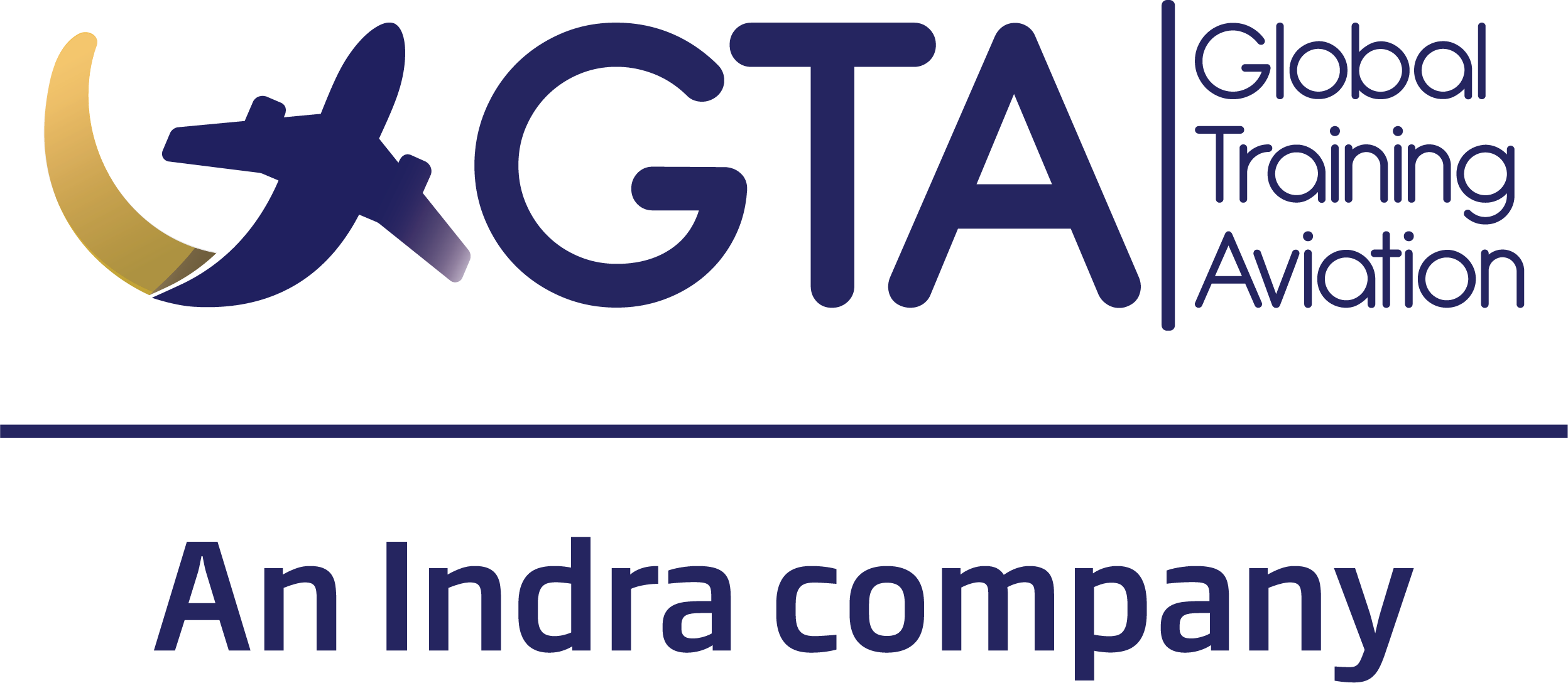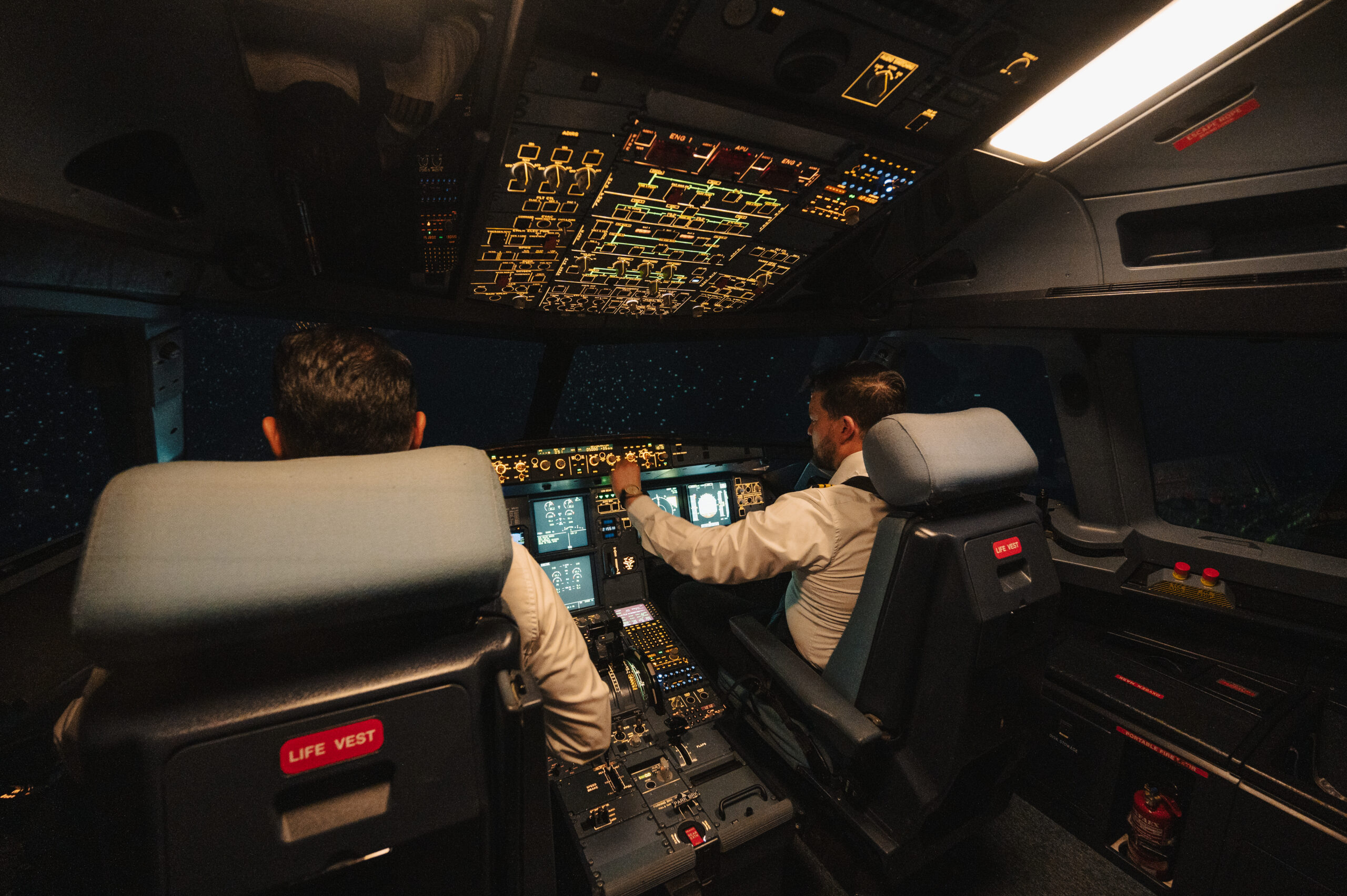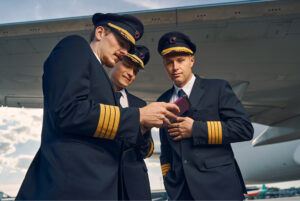Los pilotos profesionales, especialmente aquellos que trabajan en aerolíneas comerciales, se entrenan utilizando simuladores de vuelo profesionales que replican con gran precisión las condiciones reales de vuelo. Estos dispositivos permiten practicar maniobras, procedimientos y situaciones de emergencia sin poner en riesgo sus vidas ni las aeronaves. En esta guía, exploramos qué simuladores utilizan, cómo están diseñados y qué tipos existen según su uso.
¿Qué es un simulador de vuelo profesional?
Definición y componentes principales
Un simulador de vuelo profesional es un sistema tecnológico avanzado que reproduce fielmente la experiencia de pilotar una aeronave. Está diseñado para la formación de pilotos en simuladores de vuelo, tanto en etapas iniciales como en entrenamientos recurrentes.
Sus componentes principales incluyen:
- Cabina realista: Réplica exacta de la cabina de modelos como el simulador de vuelo Airbus, simulador de vuelo Boeing o ATR FFS, con todos los controles operativos.
- Sistema visual envolvente: Pantallas panorámicas que simulan entornos reales con visión de 180° o 360°.
- Plataforma de movimiento: Reproduce aceleraciones, turbulencias y maniobras.
- Aviónica y sistemas de navegación: Equipos idénticos a los de la aeronave real.
- Estación de instructor: Permite controlar el entorno de entrenamiento, introducir fallos y evaluar el desempeño del piloto.
Este tipo de simulador es considerado el simulador de vuelo más realista disponible en la industria.
Tipos de simuladores según su uso
Los tipos de simuladores de vuelo se clasifican principalmente en dos categorías:
- Full Flight Simulator (FFS): Son los más completos y están certificados para entrenamiento oficial. Incluyen movimiento, sonido envolvente y visuales de alta fidelidad. Se utilizan para habilitaciones de tipo y formación recurrente. Ejemplos comunes son el A320 FFS, B737 FFS, ATR 500 y ATR 600 FFS.
- Flight Training Device (FTD): Simuladores más simples, sin plataforma de movimiento, pero con cabinas y sistemas visuales realistas. Son ideales para entrenamiento de procedimientos, navegación y preparación para certificaciones. Los más comunes son el VPT y FNPT.
Ambos tipos son fundamentales en el entrenamiento en simuladores de vuelo y se utilizan en centros especializados como Global Training Aviation, que ofrece simuladores de vuelo para pilotos de aerolíneas en España y otros países.
¿Por qué los pilotos entrenan en simuladores de vuelo?
El uso de simuladores de vuelo profesionales en la formación de pilotos no solo es una práctica común, sino esencial. Estos dispositivos permiten entrenar en entornos controlados, seguros y altamente realistas, lo que mejora la preparación del piloto ante cualquier situación que pueda surgir en un vuelo.
Seguridad y reducción de riesgos
Uno de los principales motivos de entrenar en simuladores de vuelo para formación de pilotos es la seguridad. En estos entornos virtuales, los instructores pueden simular fallos técnicos, condiciones meteorológicas adversas o emergencias médicas sin poner en riesgo vidas humanas ni aeronaves reales.
El entrenamiento de pilotos en simulador permite repetir maniobras complejas, practicar aterrizajes en condiciones extremas y tomar decisiones críticas en tiempo real. Esto reduce significativamente los riesgos durante el vuelo real y mejora la capacidad de respuesta del piloto ante imprevistos.
Entrenamiento en condiciones extremas
Los full flight simulator (FFS) y flight training devices (FTD) permiten recrear escenarios que serían imposibles o peligrosos de practicar en vuelo real: tormentas eléctricas, pérdida de motor, aterrizajes forzosos, entre otros.
Gracias a la tecnología avanzada de simuladores como el A320 FFS, B737 FFS o ATR FFS, los pilotos pueden entrenar en condiciones extremas con total seguridad. Este tipo de preparación es clave para pilotos de aerolíneas, que deben estar listos para enfrentar cualquier situación durante sus operaciones.
Mejora de la eficiencia y costes
Además de la seguridad, el uso de simuladores de vuelo en España y en todo el mundo permite optimizar recursos. El entrenamiento en simuladores de vuelo reduce los costes operativos al evitar el uso de aeronaves reales, combustible y espacio aéreo.
Centros como Global Training Aviation ofrecen programas de formación con simuladores de vuelo para pilotos de aerolíneas que permiten entrenar de forma intensiva, eficiente y económica. Esto no solo beneficia a las compañías aéreas, sino también a los propios pilotos, que pueden acceder a más horas de práctica en menos tiempo.
Principales simuladores de vuelo usados por pilotos
Los pilotos, especialmente los que trabajan en aerolíneas comerciales, se entrenan en simuladores certificados que reproducen con gran precisión las condiciones reales de vuelo. Los más utilizados son los Full Flight Simulator (FFS) y los Flight Training Device (FTD), cada uno con características específicas según el tipo de entrenamiento requerido.
Full Flight Simulator (FFS)
El Full Flight Simulator (FFS) es el tipo de simulador más avanzado y completo. Está certificado para realizar entrenamientos oficiales y habilitaciones de tipo. Incluye:
- Cabina realista con todos los controles funcionales.
- Sistema visual envolvente de alta definición.
- Plataforma de movimiento con seis grados de libertad.
- Sonido ambiental que simula el entorno de vuelo.
Este tipo de simulador permite realizar entrenamiento en simuladores de vuelo en condiciones extremas, simulando fallos técnicos, condiciones meteorológicas adversas y procedimientos de emergencia.
Flight Training Device (FTD)
El Flight Training Device (FTD), como se ha mencionado anteriormente, es más sencillo y se utiliza principalmente para:
- Entrenamiento de procedimientos previos al entrenamiento en FFS.
- Prácticas de navegación y comunicación.
- Preparación para exámenes teóricos y prácticos.
Aunque no ofrece la misma inmersión que un FFS, el FTD es una herramienta eficaz y económica para la formación de pilotos en simuladores de vuelo, especialmente en etapas iniciales.
Modelos más usados por aerolíneas
Las aerolíneas suelen utilizar simuladores específicos según el tipo de aeronave que operan. Los modelos más comunes incluyen:
- A320 FFS: Utilizado por aerolíneas que operan el Airbus A320, uno de los aviones más populares en vuelos de corto y medio alcance.
- B737 FFS: Simulador del Boeing 737, ampliamente usado en aerolíneas de todo el mundo.
- ATR FFS: Simulador del ATR 72, ideal para vuelos regionales.
Simuladores de vuelo en la formación de pilotos
La formación de pilotos en simuladores de vuelo es una parte esencial del proceso de entrenamiento profesional. Gracias a los avances tecnológicos, los simuladores permiten replicar con precisión todas las fases del vuelo, desde el arranque de motores hasta aterrizajes en condiciones extremas. Esta metodología garantiza que los pilotos estén preparados para operar con seguridad y eficiencia en cualquier situación.
Etapas del entrenamiento
El entrenamiento en simuladores se divide en varias etapas, adaptadas al nivel de experiencia del piloto y al tipo de aeronave que va a operar. Estas etapas incluyen:
- Familiarización con la cabina: Uso de Flight Training Device (FTD) para conocer los sistemas y controles.
- Procedimientos normales: Práctica de despegues, aterrizajes, navegación y comunicación.
- Procedimientos anormales y de emergencia: Entrenamiento en Full Flight Simulator (FFS) para simular fallos técnicos, condiciones meteorológicas adversas y toma de decisiones críticas.
- Evaluaciones recurrentes: Simulaciones periódicas para mantener la habilitación de tipo y cumplir con los estándares de seguridad.
Simulación de procedimientos de emergencia
Una de las grandes ventajas del entrenamiento en simuladores de vuelo es la posibilidad de practicar situaciones de emergencia sin riesgos reales. Los instructores pueden simular:
- Fallos de motor.
- Incendios a bordo.
- Despresurización de cabina.
- Aterrizajes forzosos en condiciones adversas.
Estos escenarios se realizan en simuladores como el A320 FFS, B737 FFS o ATR FFS, que permiten una experiencia inmersiva y realista. Este tipo de entrenamiento mejora la capacidad de reacción del piloto y fortalece su toma de decisiones bajo presión.
Colaboración y trabajo en cabina
Además de las habilidades técnicas, los simuladores fomentan el trabajo en equipo dentro de la cabina. Los pilotos entrenan junto a copilotos e instructores, desarrollando habilidades de comunicación, coordinación y liderazgo.
La colaboración entre los miembros de la tripulación es clave para garantizar la seguridad del vuelo. Esta formación es especialmente importante en vuelos comerciales, donde cada decisión debe ser consensuada y ejecutada con precisión.
¿Cuál es el simulador de vuelo más realista?
El simulador de vuelo más realista es el Full Flight Simulator (FFS). Se considera el estándar más alto porque:
- Reproduce fielmente la cabina de aeronaves reales como el A320 FFS, B737 FFS o ATR FFS.
- Incluye una plataforma de movimiento que simula aceleraciones, turbulencias y maniobras.
- Ofrece un sistema visual envolvente de alta definición.
- Permite entrenar en procedimientos normales y de emergencia con total precisión.
Preguntas frecuentes
¿Qué simuladores usan los pilotos de aerolíneas?
Los pilotos de aerolíneas se entrenan principalmente en Full Flight Simulator (FFS), como el A320 FFS, B737 FFS o ATR FFS, que ofrecen una experiencia inmersiva y están certificados para formación oficial. También utilizan Flight Training Device (FTD) para prácticas de procedimientos y navegación, sobre todo en las primeras fases de la habilitación de tipo.
¿Cuál es el mejor simulador para nuevos pilotos?
Para nuevos pilotos que se están formando en aeronaves comerciales, el mejor simulador depende del tipo de avión que vayan a operar. Los más recomendados son:
- A320 FFS: Ideal para quienes se entrenan en el Airbus A320, muy común en vuelos de corto y medio alcance.
- B737 FFS: Perfecto para pilotos que se preparan para volar el Boeing 737, uno de los modelos más utilizados en aerolíneas.
- ATR FFS: Recomendado para formación en vuelos regionales con aeronaves turbo propulsadas como el ATR 72.
¿Cuánto cuesta un simulador profesional?
El precio de un simulador de vuelo profesional varía según el modelo y nivel de realismo. Un Full Flight Simulator puede costar entre 8 y 15 millones de euros, mientras que un FTD tiene un coste mucho menor. Centros como Global Training Aviation ofrecen acceso a estos simuladores sin necesidad de adquirirlos.







